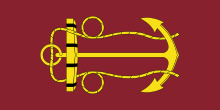Admiralty in the 16th century
 |
|
| Agency overview | |
|---|---|
| Formed | 1410-1964 |
| Jurisdiction |
|
| Headquarters | Admiralty, Whitehall, Westminster, London |
| Agency executive | |
| Parent agency | English government |
The office of the Admiralty and Marine Affairs oversaw the creation of standing "Navy Royal", during the 16th century with its own secretariat, dockyards and a permanent core of purpose-built warships, originated in the early 16th century during the reign of Henry VIII. Under Elizabeth I England became involved in a war with Spain, which saw privately owned ships combining with the Royal Navy in highly profitable raids against Spanish commerce and colonies. In 1588, Philip II of Spain sent the Spanish Armada against England to end English support for Dutch rebels, to stop English corsair activity and to depose the Protestant Elizabeth I and restore Catholicism to England. The Spaniards sailed from Lisbon, planning to escort an invasion force from the Spanish Netherlands but the scheme failed due to poor planning, English harrying, blocking action by the Dutch, and severe storms. A Counter Armada, known as the English Armada, was dispatched to the Iberian coast in 1589, but failed to drive home the advantage England had won upon the dispersal of the Spanish Armada in the previous year.
The English experiment of different types of government began to develop during this period. The Monarchs leading advisers led to creation of the Privy Council of England that became the central body of the government of the Tudors and the Stuarts The Privy Council, the central authority of Tudor government originally, this was a select group of the full royal council, but in time, it became too large for effective government. The Monarchs principal private secretary (would be later known as the Secretary of State during the 16th Century) was responsible for all administrative functions of the crown whilst the Treasurer of the Royal Court was in effect its chief of finance and responsible for all functions of finance relating to accounting and auditing.
In 1546 as the English Navy was expanding there was at this point no official body set up the manage it effectively this led to the creation of council of advisers to the Lord High Admiral known as the ‘Council of the Marine’ formed by group of court officials with the consent of King Henry VIII that would act as an advisory committee, this council would evolve into the Navy Board. This new Navy Office would be the first permanent attempt to establish effective naval administration the boards remit was the construction of ships, the maintenance of ships including repairs and the control and administering the Royal Dockyards
...
Wikipedia
